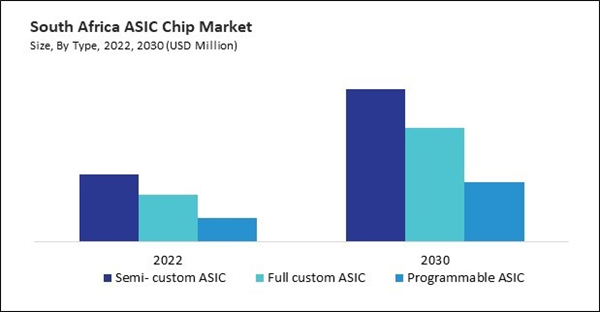The Brazil market dominated the LAMEA ASIC Chip Market by Country in 2022, and would continue to be a dominant market till 2030; thereby, achieving a market value of $816.9 million by 2030. The Argentina market is registering a CAGR of 11.4% during (2023 - 2030). Additionally, The UAE market would showcase a CAGR of 10.5% during (2023 - 2030).
The ASIC chip is not static; it is characterized by dynamic trends that reflect the evolving needs of industries and technological advancements. One prominent trend is the increasing focus on energy efficiency. ASICs designed for optimal energy efficiency gain prominence as power consumption becomes critical in various applications. This trend aligns with the broader industry shift towards sustainability and green computing.
Furthermore, innovation serves as the lifeblood of the market, driving advancements that shape the future of semiconductor technology. One noteworthy innovation is the development of heterogeneous integration, combining different computing elements on a single chip. This approach allows ASICs to work with other processing units, such as CPUs and GPUs, creating more versatile and powerful computing solutions.
Furthermore, the UAE, particularly cities like Dubai, is known for its ambitious smart city initiatives. AI plays a crucial role in smart city development, powering applications such as traffic management, public safety, and energy efficiency. ASICs optimized for AI workloads can enhance the performance and efficiency of these applications. Spending on AI is a significant economic factor as well. By 2021, Middle Eastern and African countries would spend AED 419.54 million on artificial intelligence, up 32% yearly, according to International Data Corporation. Thus, increasing AI initiatives and expanding healthcare sector in LAMEA can lead to enhanced demand for ASIC chips in the region.
Based on Type, the market is segmented into Semi- custom ASIC, Full custom ASIC, and Programmable ASIC. Based on End User, the market is segmented into Data Processing Systems, Telecommunication Systems, Aerospace Subsystem & Sensors, Consumer Electronics, Medical Instrumentation, and Others. Based on countries, the market is segmented into Brazil, Argentina, UAE, Saudi Arabia, South Africa, Nigeria, and Rest of LAMEA.
List of Key Companies Profiled
- Advanced Micro Devices, Inc.
- Samsung Electronics Co., Ltd. (Samsung Group)
- ON Semiconductor Corporation
- Taiwan Semiconductor Manufacturing Company Limited
- NVIDIA Corporation
- Intel Corporation
- Infineon Technologies AG
- Texas Instruments, Inc.
- Seiko Epson Corporation
- BITMAIN Technologies Holding Company
Market Report Segmentation
By Type- Semi- custom ASIC
- Full custom ASIC
- Programmable ASIC
- Data Processing Systems
- Telecommunication Systems
- Aerospace Subsystem & Sensors
- Consumer Electronics
- Medical Instrumentation
- Others
- Brazil
- Argentina
- UAE
- Saudi Arabia
- South Africa
- Nigeria
- Rest of LAMEA
Table of Contents
Companies Mentioned
- Advanced Micro Devices, Inc.
- Samsung Electronics Co., Ltd. (Samsung Group)
- ON Semiconductor Corporation
- Taiwan Semiconductor Manufacturing Company Limited
- NVIDIA Corporation
- Intel Corporation
- Infineon Technologies AG
- Texas Instruments, Inc.
- Seiko Epson Corporation
- BITMAIN Technologies Holding Company









